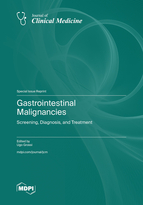Gastrointestinal Malignancies: Screening, Diagnosis, and Treatment
A special issue of Journal of Clinical Medicine (ISSN 2077-0383). This special issue belongs to the section "Gastroenterology & Hepatopancreatobiliary Medicine".
Deadline for manuscript submissions: closed (25 August 2022) | Viewed by 24354
Special Issue Editor
Interests: colorectal diseases; colorectal cancer; gastrointestinal diseases; anorectal disorders; functional defecation disorders; anal fistula; hemorrhoidal disease; inflammatory bowel diseases
Special Issues, Collections and Topics in MDPI journals
Special Issue Information
Dear Colleagues,
Gastrointestinal (GI) maligancies are a diverse group of cancers with a significant incidence and prevalence around the world. Caring for patients affected by these malignacies is complex and involves multiple disciplines. The non-specific signs and symptoms of these cancers pose a diagnostic challenge to primary care providers, which can result in delays in diagnosis. Once diagnosed, treatments are arduous, lengthy, and have a significant impact on the patient’s quality of life. Due to the involvemnet of the digestive system, nutritional issues are common among patients and affect patients’ quality of life and survival.
Despite all of these issues, the changes in the treatment landscape are helping a higher number of patients be cured or live longer. It is now encumbent upon us to better understand the needs of this population, enhance and address the care delivery pathways through better diagnosis, treatment, and support, and improve the value of care delivered to these patients and populations.
Dr. Ugo Grossi
Guest Editor
Manuscript Submission Information
Manuscripts should be submitted online at www.mdpi.com by registering and logging in to this website. Once you are registered, click here to go to the submission form. Manuscripts can be submitted until the deadline. All submissions that pass pre-check are peer-reviewed. Accepted papers will be published continuously in the journal (as soon as accepted) and will be listed together on the special issue website. Research articles, review articles as well as short communications are invited. For planned papers, a title and short abstract (about 100 words) can be sent to the Editorial Office for announcement on this website.
Submitted manuscripts should not have been published previously, nor be under consideration for publication elsewhere (except conference proceedings papers). All manuscripts are thoroughly refereed through a single-blind peer-review process. A guide for authors and other relevant information for submission of manuscripts is available on the Instructions for Authors page. Journal of Clinical Medicine is an international peer-reviewed open access semimonthly journal published by MDPI.
Please visit the Instructions for Authors page before submitting a manuscript. The Article Processing Charge (APC) for publication in this open access journal is 2600 CHF (Swiss Francs). Submitted papers should be well formatted and use good English. Authors may use MDPI's English editing service prior to publication or during author revisions.
Keywords
- Gastrointestinal malignancies
- Cancer outcomes
- Cancer survivorship
- Value in cancer care
- Equitable care







